If you have been to Alaska in the winter, you may know how incredible our night sky views are. Ever wanted to go stargazing in Alaska? The night sky view in Alaska can be one of the best places to see the stars.
Our cold winter nights remove moisture from the air – thus giving you a clearer view of the stars above. Take that along with removing city light pollution and you have a setting for the best stargazing views!

Is Alaska A Good Place To Stargaze?
Alaska is an excellent place to stargaze. The state’s remote location, clear skies, and minimal light pollution make it one of the best places in the world to view the night sky.
Alaska is a great place for looking up at the night sky for several reasons:
- Remote location: Most of Alaskan land is located far from major cities and industrial areas, which means there is minimal light pollution. This makes it easier to see stars and other celestial objects in the night sky.
- Clear skies: Alaska has a relatively dry climate, which means that cloud cover is minimal. This means that the night sky is typically clear, making it easier to see stars, planets, and even the aurora borealis.
- Dark skies: Alaska’s remote wilderness areas and national parks, such as Denali National Park and Preserve and Wrangell-St. Elias National Park and Preserve, offer some of the darkest skies in North America. This makes it easy to see stars and other celestial objects that might be difficult to see in other parts of the world.
- Northern lights: Alaska is located within the auroral oval, making it one of the best places in the world to see the northern lights, also known as aurora borealis. The best time to see the northern lights in Alaska is during the winter months, when the nights are longest.
- High Altitude: Alaska’s high altitude mountain ranges offer a clear view of the night sky, with minimal obstruction from natural or man-made objects.
There are plenty of great reasons to get outside after dark in Alaska!
Want to see the Northern Lights? Here are the best places to see the aurora near Anchorage.
What Is A Dark Sky Park?
A Dark Sky Park is a designation given by the International Dark-Sky Association (IDA) to a park or protected area that has an exceptional quality of night skies and a commitment to preserving the natural darkness. To be designated as a Dark Sky Park, an area must meet certain requirements set by the IDA, including:
- Natural darkness: The area must have a night sky that is free from excessive artificial light pollution, and must have minimal light pollution in the surrounding area.
- Dark Sky Education and Public Outreach: Dark Sky Parks must offer educational and interpretive programs and opportunities to the public, such as ranger-led night sky viewing events, star parties, and educational materials.
- Light pollution management: Dark Sky Parks must have a comprehensive and enforceable lighting management plan in place to protect the night skies and reduce light pollution.
- Dark Sky friendly lighting: Dark Sky Parks must use outdoor lighting fixtures that are fully shielded and directed downwards to reduce glare and light trespass, and to minimize the impact on the night sky.
A Dark Sky Park is a park or protected area that has exceptional quality of night skies, minimal light pollution, and a commitment to preserving the natural darkness.
Are There Any Dark Sky Parks In Alaska?
While much of Alaska qualifies for the designation, only two spots are officially designated by the International Dark-Sky Association (IDA):
- Wrangell-St. Elias National Park and Preserve was designated as a Dark Sky Park by the IDA in 2018.
- Denali National Park and Preserve was designated as a Dark Sky Park by the IDA in 2021.
However, the entire state is under a “Bortle 2” on the Bortle Scale, the majority of Alaska coming in at only a 1. The Bortle Scale ranges from Class 1 to Class 9, with 1 being the darkest and 9 being the brightest with light pollution.
Where Are The Best Places To Stargaze In Alaska?
Denali National Park and Preserve
Denali National Park and Preserve, located in the heart of Alaska, is a stargazer’s paradise and an official recipient of designation of Dark Sky Park by the IDA. With its remote location and minimal light pollution, the park offers some of the best stargazing opportunities in the world. Whether you are a seasoned stargazer or a beginner just starting out, Denali is the perfect place to enjoy the beauty of the night sky.
The first step in stargazing at Denali National Park and Preserve is to plan your visit. The best time to visit for stargazing is during the winter months, when the nights are longest. The summer months are home to the midnight sun, so you won’t have a chance to stargaze then.
Once you have your trip planned, it is time to prepare for your stargazing adventure. The key to successful stargazing is to have the right equipment. A good pair of binoculars or a telescope will enhance your viewing experience, and a star chart or sky map will help you identify the constellations and other celestial objects.
When you arrive at the park, there are several great places to stargaze. The park’s main road, the Denali Park Road, offers several pullouts where you can stop and enjoy the night sky. The park also has several campgrounds, such as the Riley Creek Campground, which offer great stargazing opportunities. If you’re looking for a more remote location, the park also has several backcountry camping areas that offer even darker skies.
One of the best things about stargazing at Denali National Park and Preserve is the chance to see the aurora borealis, or northern lights. The park is located in the heart of the aurora oval, which makes it a prime location for viewing the northern lights.
It is also important to note that light pollution can affect the visibility of the night sky. It is always good to check the park’s website for the park’s regulations on lighting and make sure to bring a red light flashlight which will not affect your night vision. Also, it is a good idea to bundle up in warm clothes and a blanket, since it can get quite chilly at night in the park. Temperatures of well below zero are normal in Denali National Park in the winter.
With a little preparation and the right equipment, you can experience the beauty of the night sky like never before. Don’t miss the chance to visit Denali National Park and Preserve and witness the beauty of the night sky.
Wrangell-St. Elias National Park and Preserve
Wrangell-St. Elias National Park and Preserve is a stargazer’s paradise in the winter. The park, located in south-central Alaska, was designated as an International Dark-Sky Park by the International Dark-Sky Association (IDA) in 2018. The park offers visitors the opportunity to experience the beauty of the night sky with minimal light pollution and the chance to spot aurora borealis.
The park is home to several remote wilderness areas that offer exceptional stargazing opportunities. The best way to stargaze in the park in the winter is to head to one of the few backcountry cabins or wilderness lodges open and accessible during the winter months.
When planning your trip, it is important to note that the park is only accessible by snowmobile, skis or snowshoes during the winter months. This means that the park is not as crowded as other national parks, making it the perfect place to escape the light pollution of urban areas and enjoy the natural beauty of the night sky.
McCarthy, a small town at the entrance to Wrangell-St Elias, does have a road that some travel on, but the road is not maintained in the winter. To ride it, it is recommended that you have plenty of experience driving
The temperatures also get very cold during the winter in Wrangell-St Elias National Park, frequently falling below 0 degrees, especially with windchill. Keep this in mind as you plan your trip to this beautiful national park.
Chena Hot Springs
Chena Hot Springs is a prime location for stargazing in Alaska, offering a unique and awe-inspiring experience for visitors. The remote location of the resort, located in the heart of the Alaskan wilderness, provides an ideal environment for stargazing, away from the light pollution of urban areas.
One of the main reasons why Chena Hot Springs is a great place for stargazing is the clear and stable weather conditions in the area. Clear skies provide optimal visibility of celestial objects, including stars, galaxies, and the aurora borealis, or northern lights. The northern lights are a common sight in the area around Chena Hot Springs, making it a prime spot for stargazing.
The resort also offers various stargazing and aurora borealis viewing opportunities, such as guided tours, telescopes, and even an aurora viewing tour up to the top of Charlie Dome. The yurt on top provides a lovely place to warm up and an enhanced stargazing experience, allowing visitors to see the night sky in a unique and intimate way.
Additionally, Chena Hot Springs Resort offers other activities such as hot springs, skiing, snowmobiling, and more, making it an ideal location for a winter getaway. It’s an easy day trip from Fairbanks, or better yet – stay the night at the resort.
The combination of stargazing and other activities makes for a memorable and enjoyable experience for visitors.
Chena Hot Springs Resort
- Address: 17600 Chena Hot Springs Road, Fairbanks, AK 99712
- Phone: (907) 451-8104
- Email: [email protected]
- Website: chenahotsprings.com
- Social Media: Facebook | Instagram | Twitter
Murphy Dome
Murphy Dome, located just 40 minutes outside of Fairbanks, Alaska, is a great spot for stargazing, offering a unique and awe-inspiring experience for visitors. The remote location of the dome, situated in the heart of the Alaskan wilderness, provides an ideal environment for stargazing, away from the light pollution of urban areas.
Murphy Dome, when clear, provides optimal visibility of celestial objects, including stars, galaxies, and the aurora borealis, or northern lights. The northern lights are a common sight in the area around Murphy Dome, making it a good spot for stargazing.
The dome is located at an elevation of just under 3,000 feet which provides an unobstructed view of the night sky. Additionally, being in a remote location and away from any nearby towns or cities, there is no light pollution, offering a perfect spot to kick back, relax, and stargaze.
Your only companions are likely to be the wildlife and any ATV riders or hikers that want to join the show!
Eklutna Lake
Eklutna Lake is a prime destination for stargazing. With its close proximity to Anchorage, and gorgeous mountain-framed night sky, Eklutna Lake is a gorgeous spot to stargaze. If you have photography equipment and are talented at taking nighttime photos, this is a great place to do so. The reflections of the stars in the water would make a beautiful photo.
The lake is located in Chugach State Park, which offers visitors access to a variety of outdoor activities, such as hiking, fishing, and snowmobiling. The public use cabins also make it an ideal location for a winter getaway.
The combination of stargazing and other activities makes for a memorable and enjoyable experience for visitors.
Flattop
Flattop is one of the best places to stargaze if you don’t want to get too far away from Anchorage.
The mountain is easily accessible, which makes it a popular destination for both amateur and professional stargazers. The Flattop Mountain trailhead is located just a short 15 minute drive from downtown Anchorage, making the trailhead easy to reach for visitors who want to experience the night sky.
When you arrive, you can take a short 5 minute walk from the parking lot to see the city lights below, or hike 1.5 miles up the trail to some spectacular nighttime scenery.
Turnagain Arm
Drive the Seward Highway and pullover on one of the pullouts when the city lights disappear behind you. There is a reason why the Seward Highway is designated a “National Scenic Byway!”
Watch the stars above you, and if you are really lucky, you may even see the aurora borealis if the forecast is good.
Another great feature of Turnagain Arm is the beautiful landscapes – you can enjoy the stunning views of the mountains, water, and wildlife while stargazing. This also makes it a great spot for photography enthusiasts.
Our favorite part? Turnagain Arm is also easily accessible, which makes it a popular destination for both amateur and professional stargazers. The arm is located just a short drive from Anchorage, making it easy to reach for those who want to experience the night sky.
Hatcher Pass
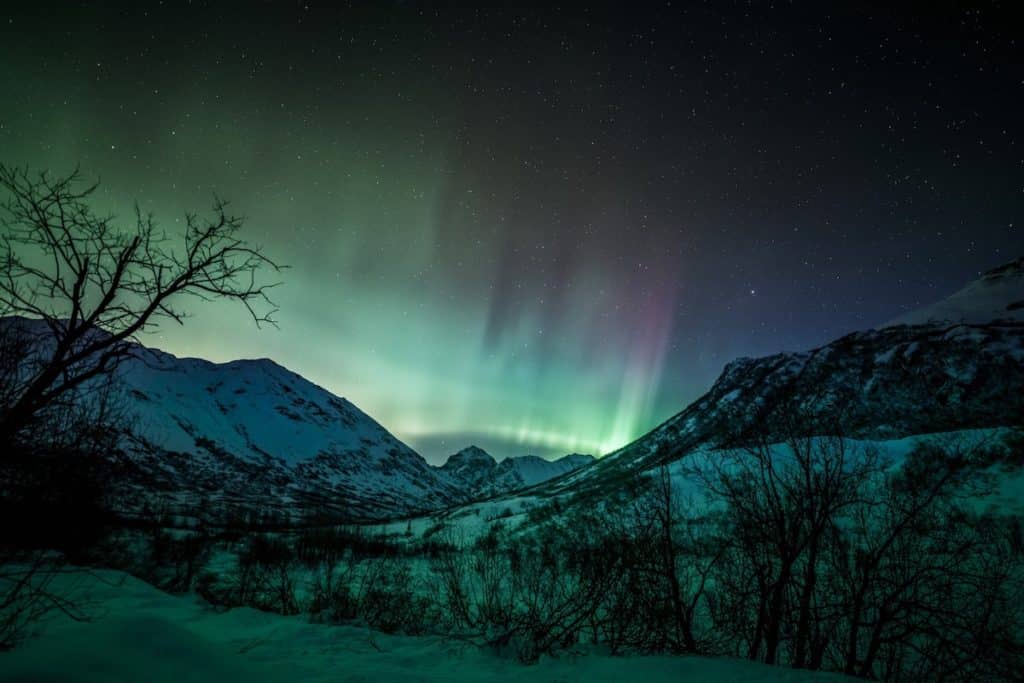
An hour outside of Anchorage, or just minutes outside of Palmer, is Hatcher Pass. Drive up into the mountains to get a world-class view of the stars without any of the light pollution below.
You will be climbing 3,885 feet into this mountains pass, which means unobstructed views of the night sky above. And if the weather is cold, clear, and dry, you have the perfect location for stargazing!
Honestly, Just About Anywhere In The State
Alaska is three times the size of Texas, but we only have just over 700,000 residents. That means there is a ton of undeveloped land all over the state. You can drive 15-20 minutes from any city or town, including Anchorage – the largest city in the state – and find prime stargazing opportunities.
If you check the Bortle Light Pollution Map, over 90% of the state is Bortle 1– the very best designation for stargazing. So pack up your gear, make sure to stay warm, and head on out into the darkness of Alaska for some unparalleled spots to soak in the starlight.
What Kind Of Celestial Objects Can You See When You Stargaze In Alaska?
The night sky is full of beauty in the winter time, and with Alaska’s cold, dry weather the sky is usually sparkling. But you won’t just see stars in Alaska. You will have the chance to see a whole lot more!
Constellations
You can see a variety of constellations in the night sky, including those that are visible year-round and others that are only visible during certain seasons. Some of the constellations that can be seen in Alaska include:
- The Big Dipper and Little Dipper, which are part of the constellation Ursa Major (the Great Bear) and Ursa Minor (the Little Bear) respectively.
- Cassiopeia, a constellation in the shape of a “W” that can be seen in the northern sky.
- Orion, which is one of the most recognizable constellations and includes stars such as Betelgeuse and Rigel.
- The Pleiades, an open star cluster also known as the Seven Sisters.
- The constellation Draco (Dragon)
- The constellation Cygnus (The swan)
- The constellation Lyra (The Harp)
Planets
From Alaska, you can see several planets in the night sky at various times of the year. Some of the planets that are visible from Alaska include:
- Mercury: This planet is the closest to the sun and is not visible often and it’s best viewed in the early morning or late evening
- Venus: Venus is one of the brightest objects in the night sky and can be visible in the morning or evening, depending on the season.
- Mars: Mars is visible in the night sky and can be easily distinguished by its reddish color.
- Jupiter: Jupiter is visible in the night sky and is the largest planet in our solar system.
- Saturn: Saturn is visible in the night sky and is known for its rings.
- Uranus and Neptune: They are not visible to the naked eye and require a telescope to be viewed.
Keep in mind that the visibility of these planets can vary depending on factors such as the time of year, time of day, and weather conditions. Additionally, some planets, like Mercury and Venus, may not be visible at all times of the year.
Meteors and Meteor Showers
From Alaska, you can see several meteor showers throughout the year, depending on the time of year. Some of the meteor showers that are visible from Alaska include:
- Quadrantids: This meteor shower is active in early January and is known for its bright and colorful meteors.
- Lyrids: This meteor shower is active in late April and is known for its blue-white meteors. This shower is best viewed from the southern and southcentral parts of the state, due to the long daylight hours.
- Eta Aquarids: This meteor shower is active in early May and is known for its fast and bright meteors. This one is better viewed from the southern parts of the state, due to the midnight sun hours.
- Perseids: This meteor shower is active in August and is known for its high rates of up to 60-100 meteors per hour. This one is better seen in the southern part of the state, due to the daylight hours.
- Orionids: This meteor shower is active in October and is known for its bright and fast meteors.
- Leonids: This meteor shower is active in November and is known for its high rates of up to 15-20 meteors per hour.
- Geminids: This meteor shower is active in December and is known for its bright and long-lasting meteors.
Please keep in mind that meteor showers can be affected by factors such as light pollution, weather conditions, and the phase of the moon.
The best time to see meteor showers is during the darkest hours of the night, away from city lights, and under clear skies.
Aurora Borealis
The aurora borealis, also known as the northern lights, can be seen from all parts of Alaska. The aurora borealis is caused by the interaction between the solar wind and the Earth’s magnetic field, which results in the emission of light in the upper atmosphere.
The best places to see the aurora borealis in Alaska are typically in areas with low light pollution and clear skies, such as rural and remote locations.
The aurora borealis can take many forms, and its appearance can change depending on various factors such as solar activity and atmospheric conditions.
Some common forms of the aurora borealis include:
- Curtains or drapes: Long, flowing bands of light that can appear in different colors such as green, red, yellow, blue and purple. This is the most common appearance of aurora borealis.
- Pillars or columns: Vertical beams of light that can appear in different colors and can reach high into the sky.
- Flares or rays: Streaks or rays of light that can appear to shoot out from a central point and can be observed in different colors.
- Coronas: A circular halo of light that surrounds the sun or moon.
- Auroral Oval: a ring-shaped area around the earth’s magnetic poles where auroras are more likely to occur.
The best time to see the aurora borealis in Alaska is during the winter months, when the nights are longest and the skies are darkest. The aurora borealis can be visible any time of the night, but are most active during the hours around midnight or just after.
The aurora borealis is a natural phenomenon and its visibility can be affected by solar activity, so it is not guaranteed to be visible every night. The best way to stay up to date on aurora borealis activities is by checking in on the Aurora Forecast, updated regularly by the University of Alaska Fairbanks.
What Is The Best Time Of Year To Stargaze In Alaska?
Late autumn, winter, and early spring are the best times of year to stargaze in Alaska. You need darkness to truly see the stars, and our midnight sun does not allow us a great show in the summer months.
There are a combination of factors even beyond the midnight sun that make the winter a clear winner:
- The longer nights: During the winter months, the days are shorter, and the nights are longer, providing more time to observe the night sky.
- Clear Skies: The winter months in Alaska tend to have clear and stable weather conditions, which is ideal for stargazing. The cold temperatures can lead to less cloud cover and less atmospheric turbulence, which results in better visibility of celestial objects.
- Northern lights: The aurora borealis, or northern lights, is more active during the winter months and can often be seen on clear nights, making it a prime time for stargazing.
- Dark Skies: The lack of vegetation during winter months means that the night sky is clearer and darker, providing better visibility of stars, galaxies, and other celestial objects.
- Winter constellations: Some constellations, such as Cassiopeia, Orion, and the Pleiades are more visible during the winter months, making them easier to spot in the night sky.
Even though winter is the best time for stargazing in Alaska, it is still possible to observe stars and other celestial objects during the early summer months with clear skies in the southern parts of the state.
There are plenty of wonderful things to do in Alaska in the winter season– stargazing is just one of them! We love all of these things to do in Alaska in the February.
After living over 14 years in Alaska, Megan McDonald can confidently state that there’s not much of the state on the road system that she hasn’t visited. From the Brooks Range to McCarthy, Homer, and everywhere in between, every nook and cranny of Alaska is always her new favorite place.
As President and co-founder of Alaska-based boutique media agency HuMu Media, she spends her work time writing, photographing, and traveling, and her off time writing, photographing, and traveling. They say do what you love, and she is lucky enough to do so!
You can follow her travels on Instagram at @theitinerantginger

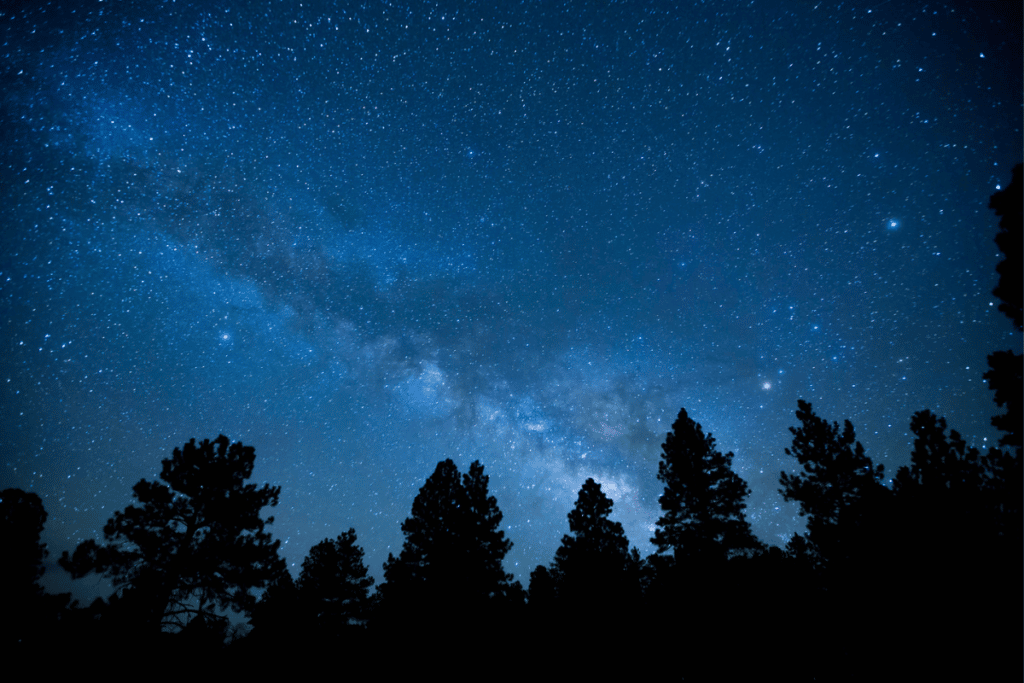
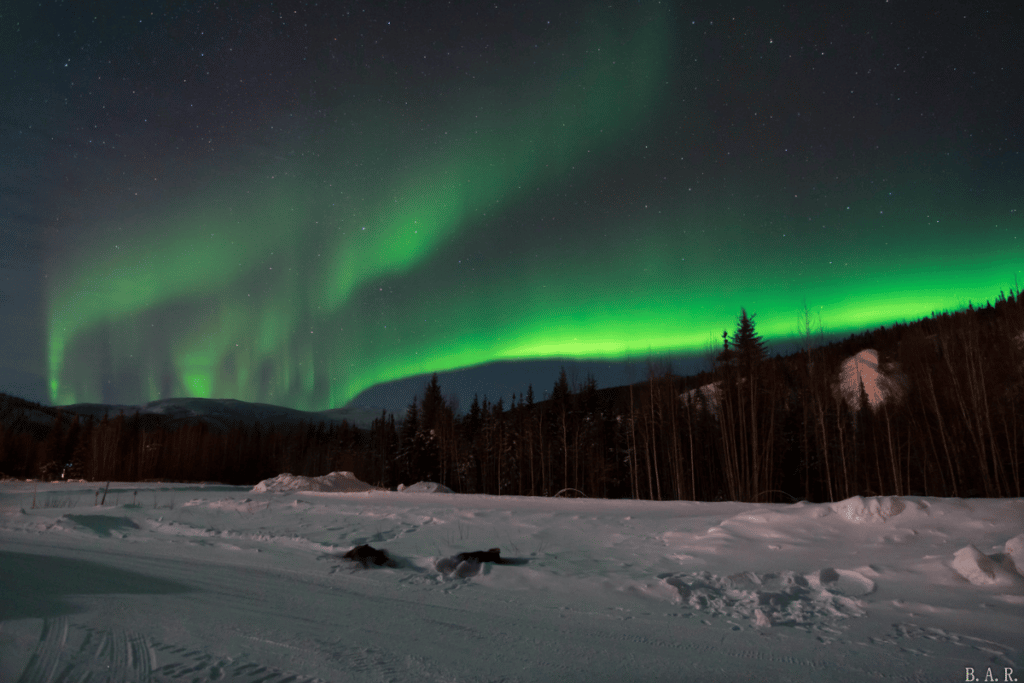
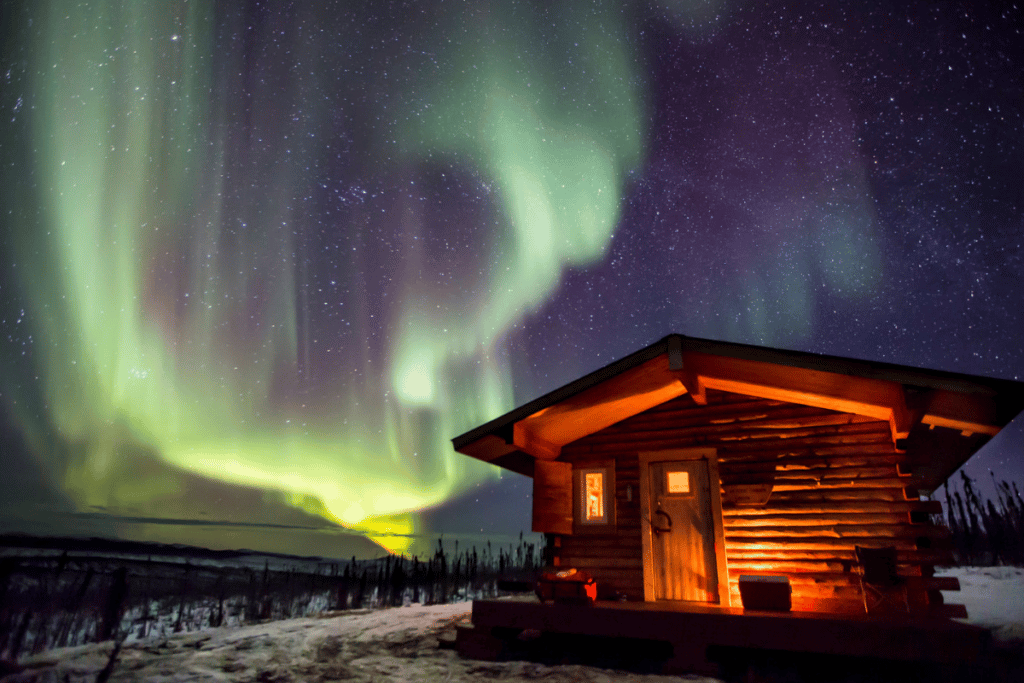
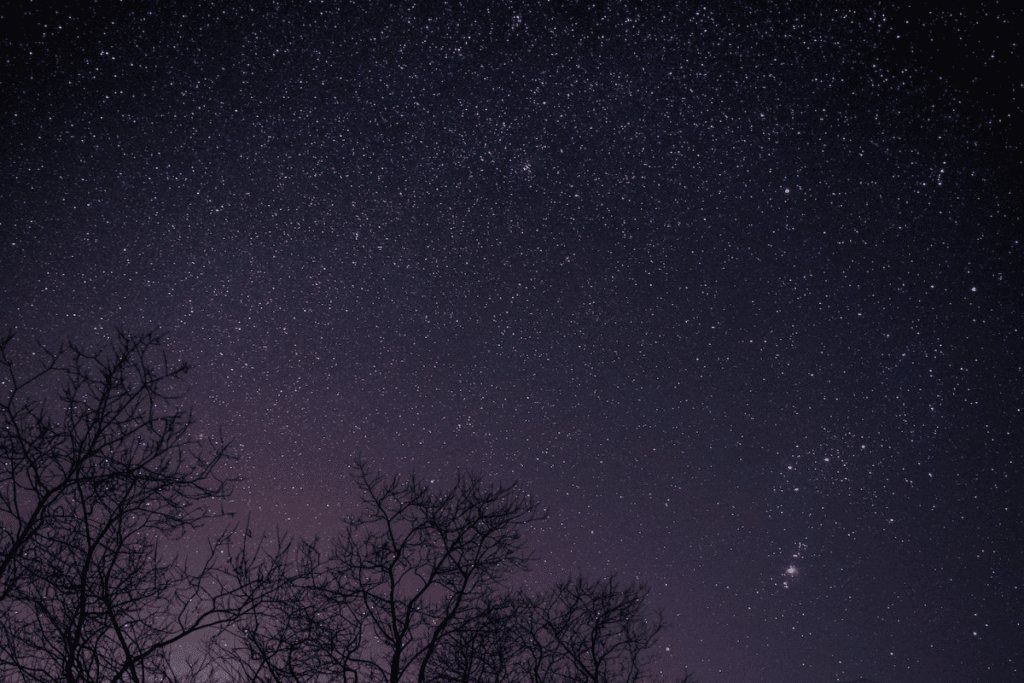
This was an excellent article. Lots of good information. Thank you!!!